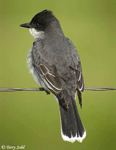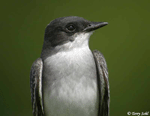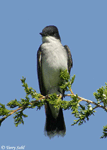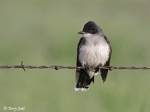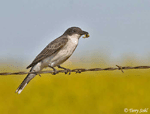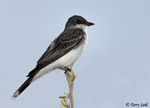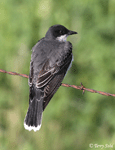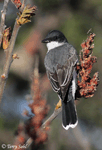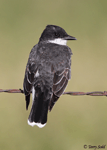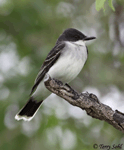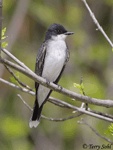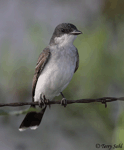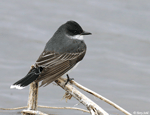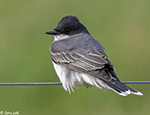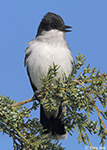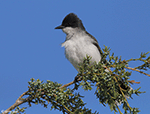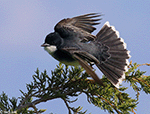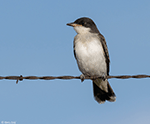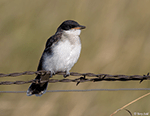Eastern Kingbird
Tyrannus tyrannus
| Length: 8.5 inches | Wingspan: 15 inches | Seasonality: Summer |
| ID Keys: White band on tip of black tail, dark upperparts with white underparts | ||
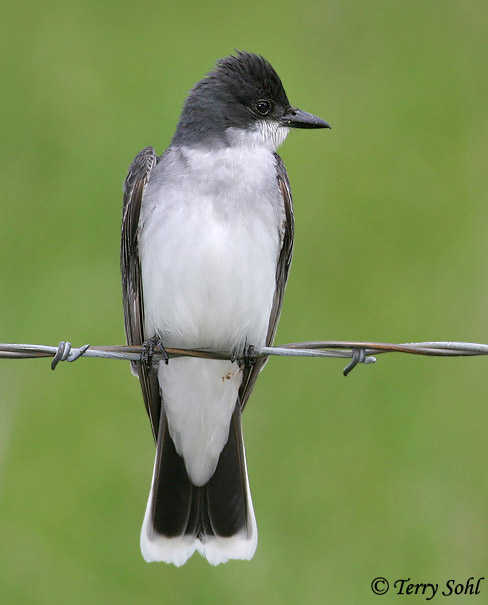 Eastern
Kingbirds are one of the "tyrant flycatchers", found in not only the
Eastern US, but across much of the US. They will defend it's
nest in an extremely aggressive manner, even attacking much larger birds
that come too close. As with other flycatchers, they often feed by
observing from a perch and flying out to catch insects in mid-air.
Eastern Kingbirds are very common sights in the summer along fence lines and
posts in most of the state.
Eastern
Kingbirds are one of the "tyrant flycatchers", found in not only the
Eastern US, but across much of the US. They will defend it's
nest in an extremely aggressive manner, even attacking much larger birds
that come too close. As with other flycatchers, they often feed by
observing from a perch and flying out to catch insects in mid-air.
Eastern Kingbirds are very common sights in the summer along fence lines and
posts in most of the state.
Habitat:
Woodland edges, roadsides, farms, shelterbelts, scattered trees. Requires open space for hunting and trees for nesting.
Diet:
Mostly insects, including grasshoppers, flies, beetles, bees, and wasps. Also will eat fruit and berries.
Behavior:
In addition to capturing flying insects, Eastern Kingbirds will also hover and glean insects from vegetation foliage and other surfaces. While they are extremely territorial during their summer months in South Dakota, they form large flocks in their wintering grounds in South America.
Nesting:
Early June through July. The nest of an Eastern Kingbird is a cup of grasses, sticks, weeds, and other vegetative material. The female usually lays 3 or 4 eggs, and she does the majority of the incubation. When the eggs hatch, both parents help feed the young. The young fledge after about 18 days, but parents typically continue to feed the young for several weeks after fledging occurs.
Song:
The song of an Eastern Kingbird is a complex series of fast buzzy and chattering notes. Calls are very short crisp tzeet notes.
- Click here to hear the song of an Eastern Kingbird1
- Click here to hear the call of an Eastern Kingbird2
Migration:
Neotropical migrant, wintering in South America. Summers throughout most of the eastern three-fourths of the United States, and southern Canada.
Interactive eBird Map:
Click here to access an interactive eBird map of Eastern Kingbird sightings
Similar Species:
The bright white underparts, white tip of the tail, and dark gray upperparts generally make it distinctive if seen well. In less than ideal viewing conditions, they could perhaps be confused with the following:
- Eastern Phoebe - Eastern Phoebes are another flycatcher species that are dark above, light below, and can sometimes be found in similar semi-open habitats as an Eastern Kingbird. Eastern Phoebes are often found near water, and in eastern South Dakota, often nest on the underside of bridges. In appearance, Eastern Phoebes are smaller birds, they lack the wing tips of the tail of the Eastern Kingbird, and have more of a brownish tone on their upperparts compared to the darker gray tone on an Eastern Kingbird.
- Eastern Wood-pewee (and Western Wood-pewee) - Both species are found in South Dakota, with one in the eastern part of the state, one in the western part of the state. Both are virtually identical in appearance and thus ID keys here are the same for the two. Habitat is one clue from differentiating Wood-pewee species from Eastern Kingbirds, as both Wood-pewee species are more likely to be seen in forested areas than are Eastern Kingbirds. However, Wood-pewees will hang out around forest edges, and Eastern Kingbirds sometimes do so as well. In appearance, both Wood-pewees lack the white tail tip of the Eastern Kingbird. Both also are lighter in tone on their upperparts than Eastern Kingbird, and have yellow on the lower mandible of the bill (compared to all black bill of the Eastern Kingbird).
- Western Kingbird - Western and Eastern Kingbird species are indeed found, respectively, in those two halves of North America, although the Eastern Kingbird ranges much further to the West, than the Western Kingbird ranges to the east. There is a very broad area of overlap between the two species, including all of South Dakota. Both species prefer similar habitat, and both can often be seen hanging out on barbed wire fences in the state. They're similar in structure and size, but plumage differences are obvious, as Western Kingbirds have lemon yellow undersides, and Eastern Kingbirds are white. Western Kingbirds also lack the white tail tip of the Eastern Kingbird.
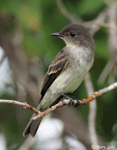 |
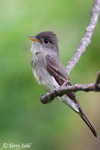 |
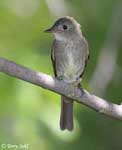 |
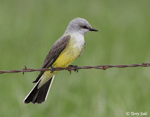 |
| Eastern Phoebe | Eastern Wood-pewee | Western Wood-pewee | Western Kingbird |
South Dakota "Hotspot"
Not a difficult species to find from at least May through August. Particularly in the eastern part of the state, driving through areas with pasture and grassland means you'll almost certainly run into an Eastern Kingbird sitting on a barbed wire fence or fence post. One of the more prevalent and easily found species in South Dakota in summer.
Conservation Status:
There are indications that populations are declining in some areas. However, they are still found over a wide geographic range, have a high overall population, and are common in some areas. The IUCN lists the Eastern Kingbird as a species of "Least Concern".
Further Information:
Photo Information:
May 26th, 2003 -- Minnehaha County -- Terry L. Sohl
Additional Photos:
Click on the image chips or text links below for additional, higher-resolution Eastern Kingbird photos.
Audio File Credits:
- 1Andrew Spencer. Recorded in Logan County, Colorado on May 23rd, 2007. Original recording and information from xeno-canto.
- 2Richard E. Webster. Recorded in Saskatchewan, Canada on June 8th, 2014. Original recording and information from xeno-canto.
| Click on the map below for a higher-resolution view |
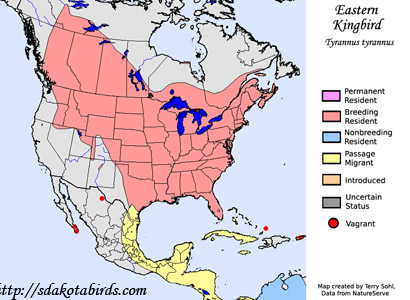 |
| South Dakota Status: Common summer resident throughout most of the state. |
Additional Eastern Kingbird Photos
Click for a higher-resolution version of these photos
